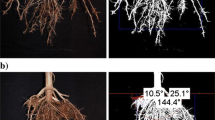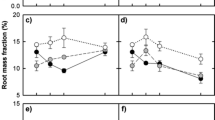Abstract
Background and aims
Biochar has been proposed as a tool to enhance phytostabilisation of contaminated soils but little data are available to illustrate the direct effect on roots in contaminated soils. This work aimed to investigate specific root traits and to assess the effect of biochar amendment on contaminant availability.
Methods
Amendment with two different types of biochar, pine woodchip and olive tree pruning, was assessed in a rhizobox experiment with maize planted in a soil contaminated with significant levels of copper and arsenic.
Results
Amendment was found to significantly improve root traits compared to the control soil, particularly root mass density and root length density. Copper uptake to plants and ammonium sulphate extractable copper was significantly less in the biochar amended soils. Arsenic uptake and extractability varied with type of biochar used but was not considered to be the limiting factor affecting root and shoot development.
Conclusions
Root establishment in contaminated soils can be enhanced by biochar amendment but choice of biochar is key to maximising soil improvement and controlling contaminant availability.







Similar content being viewed by others
References
Atkinson J, Lane A, Lord R, Street G, Scurlock J (2008) Biomass, remediation, re-generation (BioReGen Life Project): reusing brownfield sites for renewable energy crops. GeoCongress 2008:527–534
Bailey VL, Fansler SJ, Smith JL, Bolton H Jr (2011) Reconciling apparent variability in effects of biochar amendment on soil enzyme activities by assay optimization. Soil Biol Biochem 43:296–301. doi:10.1016/j.soilbio.2010.10.014
Barrett-Lennard EG, Greenway H (1982) Partial separation and characterization of soluble phosphatases from leaves of wheat grown under phosphorus deficiency and water deficit. J Exp Bot 33:694–704. doi:10.1093/jxb/33.4.694
Beesley L, Marmiroli M (2011) The immobilisation and retention of soluble arsenic, cadmium and zinc by biochar. Environ Pollut 159:474–480. doi:10.1016/j.envpol.2010.10.016
Beesley L, Moreno-Jiménez E, Gomez-Eyles JL (2010) Effects of biochar and greenwaste compost amendments on mobility, bioavailability and toxicity of inorganic and organic contaminants in a multi-element polluted soil. Environ Pollut 158:2282–2287. doi:10.1016/j.envpol.2010.02.003
Beesley L, Moreno-Jiménez E, Gomez-Eyles JL, Harris E, Robinson B, Sizmur T (2011) A review of biochars’ potential role in the remediation, revegetation and restoration of contaminated soils. Environ Pollut 159:3269–3282. doi:10.1016/j.envpol.2011.07.023
Beesley L, Marmiroli M, Pagano L, Pigoni V, Fellet G, Fresno T, Vamerali T, Bandiera M, Marmiroli N (2013) Biochar addition to an arsenic contaminated soil increases arsenic concentrations in the pore water but reduces uptake to tomato plants (Solanum lycopersicum L.). Sci Total Environ 454–455:598–603. doi:10.1016/j.scitotenv.2013.02.047
Busscher WJ, Novak JM, Evans DE, Watts DW, Niandou MAS, Ahmedna M (2010) Influence of pecan biochar on physical properties of a Norfolk loamy sand. Soil Sci 175:10–14
Carter S, Shackley S, Sohi S, Suy TB, Haefele S (2013) The impact of biochar application on soil properties and plant growth of pot grown lettuce (Lactuca sativa) and cabbage (Brassica chinensis). Agronomy 3:404–418. doi:10.3390/agronomy3020404
Clemente R, Walker DJ, Pardo T, Martínez-Fernández D, Bernal MP (2012) The use of a halophytic plant species and organic amendments for the remediation of a trace elements-contaminated soil under semi-arid conditions. J Hazard Mater 223–224:63–71. doi:10.1016/j.jhazmat.2012.04.048
Clough T, Condron L, Kammann C, Müller C (2013) A review of biochar and soil nitrogen dynamics. Agronomy 3:275–293
Gaskin JW, Steiner C, Harris K, Das KC, Bibens B (2008) Effect of low-temperature pyrolysis conditions on biochar for agricultural use. Trans ASABE 51:2061–2069
Himmelbauer ML, Loiskandl AW, Kastanek AF (2004) Estimating length, average diameter and surface area of roots using two different image analyses systems. Plant Soil 260:111–120. doi:10.1023/b:plso.0000030171.28821.55
ISO 11277 (2009) Soil quality. Determination of particle size distribution in mineral soil material. Method by sieving and sedimentation. International Organisation for Standardisation, Geneva, Switzerland.
Jones DL, Rousk J, Edwards-Jones G, DeLuca TH, Murphy DV (2012) Biochar-mediated changes in soil quality and plant growth in a three year field trial. Soil Biol Biochem 45:113–124. doi:10.1016/j.soilbio.2011.10.012
Karami N, Clemente R, Moreno-Jiménez E, Lepp NW, Beesley L (2011) Efficiency of green waste compost and biochar soil amendments for reducing lead and copper mobility and uptake to ryegrass. J Hazard Mater 191:41–48. doi:10.1016/j.jhazmat.2011.04.025
Kidd P, Barceló J, Bernal MP, Navari-Izzo F, Poschenrieder C, Shilev S, Clemente R, Monterroso C (2009) Trace element behaviour at the root–soil interface: implications in phytoremediation. Environ Exp Bot 67:243–259. doi:10.1016/j.envexpbot.2009.06.013
Lehmann J, Rillig MC, Thies J, Masiello CA, Hockaday WC, Crowley D (2011) Biochar effects on soil biota—a review. Soil Biol Biochem 43:1812–1836. doi:10.1016/j.soilbio.2011.04.022
Lin Q, Shen K-L, Zhao H-M, Li W-H (2008) Growth response of Zea mays L. in pyrene–copper co-contaminated soil and the fate of pollutants. J Hazard Mater 150:515–521. doi:10.1016/j.jhazmat.2007.04.132
Lozano-Rodriguez E, Luguera M, Lucena JJ, Carpena-Ruiz R (1995) Evaluation of two different acid digestion methods in closed systems for trace element determinations in plants. Quim Anal 14:27–30
Marschner H, Römheld V (1983) In vivo measurement of root-induced pH changes at the soil-root interface: effect of plant species and nitrogen source. Z Pflanzenphysiol 111:241–251. doi:10.1016/S0044-328X(83)80083-X
Meharg AA, Macnair MR (1992) Suppression of the high affinity phosphate uptake system: A mechanism of arsenate tolerance in holcus lanatus L. J Exp Bot 43:519–524. doi:10.1093/jxb/43.4.519
Moreno-Jiménez E, Peñalosa JM, Carpena-Ruiz RO, Esteban E (2008) Comparison of arsenic resistance in Mediterranean woody shrubs used in restoration activities. Chemosphere 71: 466–473. doi:10.1016/j.chemosphere.2007.10.030
Murphy J, Riley JP (1962) A modified single solution method for the determination of phosphate in natural waters. Anal Chim Acta 27:31–36. doi:10.1016/S0003-2670(00)88444-5
Onwubuya K, Cundy A, Puschenreiter M, Kumpiene J, Bone B, Greaves J, Teasdale P, Mench M, Tlustos P, Mikhalovsky S, Waite S, Friesl-Hanl W, Marschner B, Müller I (2009) Developing decision support tools for the selection of “gentle” remediation approaches. Sci Total Environ 407:6132–6142. doi:10.1016/j.scitotenv.2009.08.017
Prendergast-Miller MT, Duvall M, Sohi SP (2011) Localisation of nitrate in the rhizosphere of biochar-amended soils. Soil Biol Biochem 43:2243–2246. doi:10.1016/j.soilbio.2011.07.019
Prendergast-Miller MT, Duvall M, Sohi SP (2014) Biochar–root interactions are mediated by biochar nutrient content and impacts on soil nutrient availability. Eur J Soil Sci 65:173–185. doi:10.1111/ejss.12079
Revell KT, Maguire RO, Agblevor FA (2012) Influence of poultry litter biochar on soil properties and plant growth. Soil Sci. doi:10.1097/SS.0b013e3182564202
Ruiz JM, Rivero RM, Garcia PC, Baghour M, Romero L (1999) Role of CaCl2 in nitrate assimilation in leaves and roots of tobacco plants (Nicotiana tabacum L.). Plant Sci 141:107–115. doi:10.1016/S0168-9452(98)00230-1
Sukartono, Utomo WH, Kusuma Z, Nugroho WH (2011) Soil fertility status, nutrient uptake, and maize (Zea mays L.) yield following biochar and cattle manure application on sandy soils of Lombok, Indonesia. J Trop Agric 49:47–52
TMECC (2002) Test methods for the examination of composting and compost. US Composting Council, Bethesda
Vázquez S, Moreno E, Carpena R (2008) Bioavailability of metals and As from acidified multicontaminated soils: use of white lupin to validate several extraction methods. Environ Geochem Health 30:193–198. doi:10.1007/s10653-008-9143-3
Wenzel W (2009) Rhizosphere processes and management in plant-assisted bioremediation (phytoremediation) of soils. Plant Soil 321:385–408. doi:10.1007/s11104-008-9686-1
Witters N, Mendelsohn R, Van Passel S, Van Slycken S, Weyens N, Schreurs E, Meers E, Tack F, Vanheusden B, Vangronsveld J (2012a) Phytoremediation, a sustainable remediation technology? II: economic assessment of CO2 abatement through the use of phytoremediation crops for renewable energy production. Biomass Bioenergy 39:470–477. doi:10.1016/j.biombioe.2011.11.017
Witters N, Mendelsohn RO, Van Slycken S, Weyens N, Schreurs E, Meers E, Tack F, Carleer R, Vangronsveld J (2012b) Phytoremediation, a sustainable remediation technology? Conclusions from a case study. I: energy production and carbon dioxide abatement. Biomass Bioenergy 39:454–469. doi:10.1016/j.biombioe.2011.08.016
Zucconi F, Pera A, Forte M, de Bertoldi M (1981) Evaluating toxicity of immature compost. Biocycle 22:54–57
Acknowledgements
This work was carried out as part of a STSM awarded to the lead author by EU COST Action TD1107 Biochar as an option for sustainable resource management. We thank Dr Peter Anderson at SETN (Scottish Environmental Technology Network) for the IC analysis. We thank Dr Saran Sohi of the UKBRC (UK Biochar Research Centre, University of Edinburgh), Edinburgh, for checking the manuscript before submission. We also thank the two anonymous reviewers for improving the manuscript with their comments.
Author information
Authors and Affiliations
Corresponding author
Additional information
Responsible Editor: Simon Jeffery.
Electronic supplementary material
Below is the link to the electronic supplementary material.
ESM 1
(DOCX 42 kb)
Rights and permissions
About this article
Cite this article
Brennan, A., Jiménez, E.M., Puschenreiter, M. et al. Effects of biochar amendment on root traits and contaminant availability of maize plants in a copper and arsenic impacted soil. Plant Soil 379, 351–360 (2014). https://doi.org/10.1007/s11104-014-2074-0
Received:
Accepted:
Published:
Issue Date:
DOI: https://doi.org/10.1007/s11104-014-2074-0




